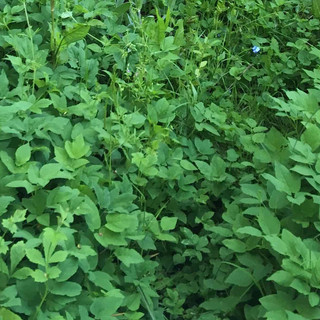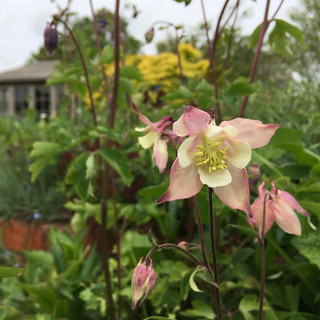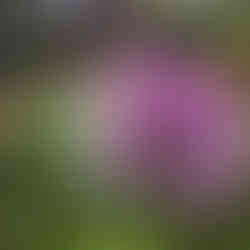May Garden Jobs
- Debi Holland

- May 8, 2020
- 5 min read
Updated: Apr 21, 2021

The merry month of May is here and what a month it has been so far! Lockdown has given most of us more time in the garden and the opportunity to observe wildlife, be it birds, bees or butterflies. As the world stopped, it was important to take note of what was going on around us, to stop and listen. I personally have been enthralled by the uninterrupted birdsong, no longer muffled by cars and incessant aeroplane engines. Blossom bloomed and every day another treasure seemed to appear from the undergrowth. New growth brings promise and the anticipation of summer.
Like a sundial an orchard is a great teller of the passing of time. The season can be gauged on where the fruit trees are in their cycle. I am very fortunate to work in a beautiful orchard which hosts many heritage apple varieties such as Blenheim Orange, Beauty of Bath, Ashmead Kernel and Court de Wick. Their blossom is a tremendous wildlife magnet.
A couple of years ago we had some unwanted visitors in the orchard so attempted to tackle with a pheromone trap; an organic pesticide-free method to curb codling moth. As a nature gardener I am a little torn to use these now as even pests have a place in the garden ecosystem but it was an interesting experiment to see what, if any difference the traps made.

The trap is hung in the middle of an orchard, one trap per five trees, on the side of the prevailing wind and lures in unsuspected male codling moths with a potent female pheromone. Sadly for them, rather than finding a mate they find a sticky end in the form of sticky paper which puts a stop to their amorous antics and their lifecycle so maggots will not be laid in the apples so crops will not be damaged.
The trap did indeed catch some codling moths and the apple crop definitely had a far lower level of maggot damage than the previous years. The advantage of using this method is it does not obliterate codling moth but reduces the population in a chemical-free way which does not damage the environment or surrounding wildlife.

Other garden considerations for May...leave some areas of your garden 'wild.' It provides an ideal home for wildlife which is great for pollinators. Mow the lawn into an attractive shape and your wild area will become a great garden feature.
I am taking part in Plantlife's #NoMowMay and have been leaving my front lawn to grow naturally since April.

From 23 May - 31 May participants count the number of open flowers in a meter square and record them on the Plantlife website as part of their #EveryFlowerCounts campaign. I am overwhelmed with the number of blooms on my lawn and it has been a big hit with the locals both wildlife and neighbours walking by and commenting on how it cheers up their day!

As well as blooms May also brings an influx of weeds, in many forms. Seemingly tidy borders now run a mock with everything from ground elder to couch grass and sticky weed to bindweed. Annual weeds can be pulled or hoed. Perennial and tap-rooted weeds will need a firmer hand and be dug out.
It’s Chelsea Chop time! Some perennials can be cut back by a third to a half at the end of May. e.g. Echinacea purpurea, Helenium, Hylotelephium spectabile formerly Sedum, Rudbeckia, Phlox paniculata, Asters, Penstemon, Nepeta. This will delay flowering but create a longer flowering period and a denser, compact plant. If that seems a little drastic then just chop half the plant to stagger flowering.
Many plants have shone this month; one of them being Aquilegia. On my travels I have come across so many beautiful varieties. Here are a few gems.
Coming to an end but it has been a great year for tulips. I am a huge fan and have collected many over the years. If you stagger bulb planting in autumn/winter you can extend your flowering season; as some fade late blooms take their place.
Leave spring-flowering bulbs to naturally die down i.e. crocus, narcissus, muscari, tulips. Foliage needs six-eight weeks to absorb all the nutrients into the bulb to store energy for next year’s flowers. Divide overcrowded clumps.
Feed containers and borders. They are all working very hard at the moment and need their nutrition. Try organic seaweed or make your own comfrey or nettle tea.
Always check hedges for nesting birds if planning to cut back/tidy up.
Plant up containers & hanging baskets; water and feed container plants regularly.
Rose chafer beetle or Cetonia aurata have exquisite iridescent green shells and are often frowned upon due to their 'pest' reputation. The larvae unfortunately chomps through roots and the adults love various petals, particular dog rose, so they can be rather destructive.
An alternative to extinguishing them is to move them to some wild grassland or woodland where they can happily play out their role in the food chain but without eating all your beloved plants in your garden. Or you could always move them into your bug hotel!
Keep your eyes peeled though for Noble chafer, which look incredibly similar, but are in fact now sadly at risk of extinction in the wild. Their favoured surroundings are traditional orchards, but a decline in habitats has taken its toll.
Check pots for over wintering vine weevil. If found remove and replace all soil. Do not put this on your compost heap as the soil may well have eggs in it still to hatch.
Check for pests & diseases on plants i.e. lily beetle, rose black spot, greenfly.

Harden off courgettes, pumpkins, and tomatoes. Earth up potatoes. Thin out carrots, lettuce, beetroot or alternatively harvest carrots and beetroot when they are small to avoid thinning out and the remaining crop will swell as more space becomes available.
I have been growing some different varieties of beans and peas from seed this year. Phaseolus vulgaris 'Trail of Tears' which I got from the 'Friends of Bristol Botanic Gardens' seed scheme and Asparagus peas recommended by a friend. Also French beans, Purple Mangetout 'Shiraz' and Sugarsnap pea 'Delikitt' Looking forward to seeing the harvest.
Harden off annual bedding. Keep a careful eye on sweet pea seedlings. Leave out in shade in the day & return indoors at night to avoid frost.
Lay down straw around strawberries to stop fruit rotting. Net soft fruits to deter birds.
Check gooseberry bushes for sawfly caterpillars.
Look out for slugs and snails on new shoots! I personally find the best method to keep them away is to spray them with garlic solution which can be bought pre-made for example 'Garlic Wonder' or more the eco, cheaper and plastic-free method is to make your own...
Try this fabulous recipe on the Garlic Farm website.
Alternative methods are pick off by hand, copper rings, shingle/egg shells or ‘Nemaslug’ nematodes. Avoid metaldehyde-based products, these are poisonous to all wildlife, your pets and children!
Prune now or AFTER flowering – wait until they have finished their glorious floral displays before chopping back: Akebia quinata (chocolate vine), Abelia, Arbutus (strawberry tree), Camellia, Hibiscus, Kerria japonica, Prunus (laurel), Forsythia, Ribes (flowering currant), Spirea, Viburnum tinus, winter jasmine.
Ponds: remove duck & blanket weed; leave it on the side of the pond so wildlife can crawl out.
Watering: best done in morning or eve as plants use it most efficiently then. Use rainwater where possible. If time is limited, just remember any watering is better than none!
Keep greenhouses ventilated. Open windows and doors in the morning if the forecast is hot.
Plant out dahlia tubers end of May when frost risk has passed or wait till early June.
Gardens are delicately balanced ecosystems so try not to totally eradicate pests as they will be a food source for other creatures i.e. birds/frogs love slugs & snails! Everything co-existing, with no dominant species, will equal a healthy garden!
To end; a galley of a few beauties that are in their prime at the moment.
Happy gardening everyone!
All photos taken by Debi Holland © 2020










































































































































Comments